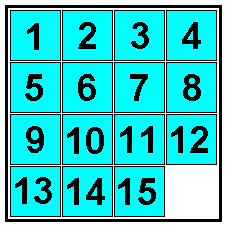Cleave Books
Sliding Block Puzzles - Introduction and Index
Sliding Block Puzzles are made up as a set of shapes which are placed inside a frame. Within that frame the shapes can be moved around only by sliding, with NO turning, lifting or jumping allowed. Usually the starting positions of the shapes are given (but might be chosen at random) together with the finishing positions which must be achieved to solve the puzzle.
Though it was not the first of this type of puzzle, the one that really started it all off was the The 15 Puzzle (described below) which was invented (by an unknown person) in 1878 in the USA and which, very quickly, spread to many other countries. It was marketed under various names - 'The Boss Puzzle' was one of them. The craze for this puzzle lasted about 3 years and several millions of people took it up. The supply could hardly keep up with the demand, and it was reported that one shop alone in New York was selling over 33,000 copies a day. All of this sounds very much like the craze for Rubik's Cube which took place almost exactly 100 years later.
|
The 15 Puzzle
This puzzle, shown on the right, has 15 numbered square blocks which are free to slide inside a 4 by 4 frame.
To start, all the blocks are taken out and then replaced at random.
The object then is to re-arrange them into their correctly ordered sequence (as shown) simply by sliding them around within the frame.
There are 1 307 674 368 000 ways the blocks can be put into the frame and in only half of those is the puzzle solvable. In all the other cases the closest solution will always have just one pair of blocks occupying each other's positions.(For example: 15 14 instead of 14 15)
|  |
The 14-15 Puzzle
It was Sam Loyd (the great American puzzlist) who in about 1881 took the 15 Puzzle and gave it a twist. He required that instead of a randomly filled starting position the numbered blocks should be put in the tray in order EXCEPT that the
14 15 blocks should be 15 14. He then offered a $1000 prize (about $40,000 at today's prices) for a solution. Thousands of people claimed to have solved it, but they could never repeat their solutions for others. As indicated above it is one of the positions for which no solution is possible. Not surprisingly the prize was never won.
Soon after this, shapes other than squares were introduced and the flow of invention has continued ever since.
|
Make your own
All of the original puzzles were made in wood or very thick card, but modern versions all use plastic. To make, and play with, the puzzles described it is best to cut the shapes out of card if possible, since paper is a little too flimsy and easily disturbed. The 'board' can just be drawn on paper. However you can make up these puzzles in any suitable material that is to hand. It is only necessary to recognise that pieces must be slid from place to place without any lifting, that pieces cannot go outside the boundary, that pieces cannot pass each other in any way unless there really is a recognised space, and that no two pieces can occupy the same space. In other words it is always necessary to observe the spirit of the rules - and you can play it in your mind if you wish.
There are now several hundred sliding block puzzles known.
Some for which details are available from this site are -
Answers are not given to problems.
You will know whether you have solved it or not!
(ALL of these ARE solvable - even if it does not feel like it sometimes.)
|
